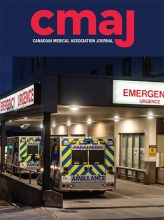An 89-year-old woman with a body mass index (BMI) of 23 presented to the emergency department with acute left medial thigh pain. She had no history of trauma. She complained of mild nausea, but had no abdominal pain. Her vital signs were normal. Physical examination showed a soft and nondistended abdomen with normal bowel sounds. The patient had no masses in the left groin region. Her deep tendon reflexes were normal and her Lasègue sign (i.e., radicular leg pain provoked by elevation of the lower extremities in the supine position) was negative. Thigh extension, abduction and internal rotation aggravated the pain, indicating a positive Howship–Romberg sign, a typical finding of obturator hernia. Computed tomography of the abdomen and pelvis showed a fluid-filled segment of small intestine between the left obturator externus and pectineus muscles (Figure 1). We made a diagnosis of obturator hernia and performed emergency surgery using an inguinal approach. The patient recovered uneventfully.
(A) Axial and (B) coronal views from computed tomography scans of an 89-year-old woman with obturator hernia, showing a fluid-filled segment of the small intestine (asterisk) that entered into the space between the left obturator externus (arrow) and pectineus muscles (arrowhead).
Obturator hernia is uncommon, accounting for about 0.1% of all hernias.1 Most patients are female (97.9%) older adults (mean age 78.8, standard deviation [SD] 13.4 yr) who are thin (mean BMI 18, SD 3) and multiparous. It is believed that a wider female pelvis with decreased preperitoneal adipose tissue results in a larger obturator canal, predisposing older women with low BMIs to obturator hernias.1 Another predisposing factor is elevated intra-abdominal pressure;1 thus, obturator hernias can occur in obese patients.2 Symptoms of obturator hernias include intestinal obstruction, abdominal pain, nausea, vomiting and fever.1 Masses are rarely palpable in the groin region.1 The hernia compresses the obturator nerve, causing pain and dysesthesia in the groin, thigh, knee and buttocks; the Howship–Romberg sign is often positive.1 Computed tomography is the most sensitive and specific imaging modality to diagnose obturator hernia.1 Because of a high probability of bowel incarceration and strangulation, urgent surgical repair is required, although 1 case of self-reduced hernia has been reported.1,3
Footnotes
Competing interests: None declared.
This article has been peer reviewed.
The authors have obtained patient consent.
This is an Open Access article distributed in accordance with the terms of the Creative Commons Attribution (CC BY-NC-ND 4.0) licence, which permits use, distribution and reproduction in any medium, provided that the original publication is properly cited, the use is noncommercial (i.e., research or educational use), and no modifications or adaptations are made. See: https://creativecommons.org/licenses/by-nc-nd/4.0/












